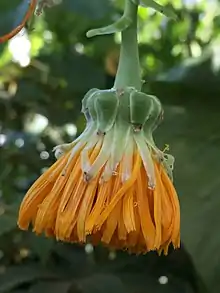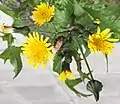Dendroseris litoralis
Dendroseris litoralis, the cabbage tree, is a small, evergreen tree species belonging the daisy and sunflower family (Asteraceae), with younger trunks ringed with pale leaf scars and distinctive rubbery, leathery leaves up to 46 centimetres (18 in) long. It is found only on the Juan Fernández Islands, west of Chile, and threatened by habitat loss. Native only to tiny, volcanic Robinson Crusoe Island, one of the Juan Fernández Islands in the southeast Pacific, far off the coast of Chile, and home of the famed Juania australis and many other fascinating endemic plants, this strange, small tree has literally been brought back from the brink of extinction. It had been reduced to only a few individuals by feral goats on the island and is still considered critically endangered. It grows into a small, gnarled tree with several somewhat palm-like crowns of very large, ovate leaves on whitish, green-spotted leaf stalks and pendent inflorescences of bright orange, tassel-like 'flowers' (capitula). It is easy to cultivate and enjoys a cool, humid climate. It is hardy to light freezes and coastal conditions.
| Dendroseris litoralis | |
|---|---|
 | |
| Scientific classification | |
| Kingdom: | |
| (unranked): | |
| (unranked): | |
| (unranked): | |
| Order: | |
| Family: | |
| Tribe: | |
| Genus: | |
| Species: | D. litoralis |
| Binomial name | |
| Dendroseris litoralis | |

Etymology
The generic name Dendroseris is a compound of the Greek elements δενδρον (dendron) 'tree' and σέρις (seris), meaning originally a type of endive and later, by extension, any type of potherb. The meaning ('the tree that yields a potherb') is thus very close in sense to that of the English common name Cabbage Tree. The Latin specific name 'litoralis' signifies 'growing by the seashore'. The binomial, in its entirety, thus means (approximately) 'the tree-cabbage that grows by the seashore'.[1] Endives (genus Cichorium) belong to the same tribe (Cichorieae) of the daisy family Asteraceae as the genus Dendroseris.
Edibility
The very large leaves are edible and formed part of the diet of voluntary castaway Alexander Selkirk - possible inspiration for Daniel Defoe's character Robinson Crusoe - during his sojourn on one of the Juan Fernandez Islands.[2][3]
Hummingbird pollination
In their recent studies Anderson et al. (2001) studied the reproductive biology of D. litoralis. They concluded that the large orange corolla capitula of D. litoralis were hummingbird pollinated, having observed hummingbird visitors on all plants observed. The same team also determined in 2000 that the nectar composition of Dendroseris litoralis has large quantities of sucrose (73%), 15% fructose and 10.9% glucose (Bernardello et al. 2000).[4]
Gallery
 Seedling. Cultivated plant.
Seedling. Cultivated plant. Canopy, viewed from beneath, of mature specimen flowering in Temperate House, Kew Gardens. (Flowers not visible in shot).
Canopy, viewed from beneath, of mature specimen flowering in Temperate House, Kew Gardens. (Flowers not visible in shot). Crown of large, edible, cabbage-like leaves that earned D. litoralis the common name of Cabbage Tree. Temperate House, Kew Gardens.
Crown of large, edible, cabbage-like leaves that earned D. litoralis the common name of Cabbage Tree. Temperate House, Kew Gardens. Young stem, showing attachment of bases of long, deeply-grooved petioles. Temperate House, Kew Gardens.
Young stem, showing attachment of bases of long, deeply-grooved petioles. Temperate House, Kew Gardens. View from above of base of single petiole, showing deep channel and attachment to stem by crescent-shaped base. Temperate House, Kew Gardens.
View from above of base of single petiole, showing deep channel and attachment to stem by crescent-shaped base. Temperate House, Kew Gardens. Crescent-shaped base of petiole of fallen leaf showing structure where formerly attached to young trunk. Temperate House, Kew Gardens.
Crescent-shaped base of petiole of fallen leaf showing structure where formerly attached to young trunk. Temperate House, Kew Gardens. Young trunk bearing distinctive pale, annular leaf scars. Temperate House, Kew Gardens. Note bud in centre of image.
Young trunk bearing distinctive pale, annular leaf scars. Temperate House, Kew Gardens. Note bud in centre of image. Upper surface of leaf at junction of petiole and lamina, showing palmate venation.
Upper surface of leaf at junction of petiole and lamina, showing palmate venation. Detail of upper surface of leaf tip, showing glossy, rubbery texture and veins patterned with elongate spots. Temperate House, Kew Gardens.
Detail of upper surface of leaf tip, showing glossy, rubbery texture and veins patterned with elongate spots. Temperate House, Kew Gardens. Part of upper surface of single leaf, back-lit to reveal fine detail of venation.Temperate House, Kew Gardens.
Part of upper surface of single leaf, back-lit to reveal fine detail of venation.Temperate House, Kew Gardens. Detail of upper surface of leaf midrib (back-lit), showing distinctive, elongate, green spots.
Detail of upper surface of leaf midrib (back-lit), showing distinctive, elongate, green spots. Wild specimen, flowering profusely in its native Juan Fernandez Islands.
Wild specimen, flowering profusely in its native Juan Fernandez Islands. Interior of pendent, yellow-orange 'flower' (capitulum). Temperate House, Kew Gardens.
Interior of pendent, yellow-orange 'flower' (capitulum). Temperate House, Kew Gardens. Sonchus sp. : common, European weed, genus of edible plants closely related to the genus Dendroseris.
Sonchus sp. : common, European weed, genus of edible plants closely related to the genus Dendroseris.
References
- Gilbert-Carter, Humphrey Glossary of the British Flora https://books.google.co.uk/books?id=rBA8AAAAIAAJ&pg=PA68&lpg=PA68&dq=meaning+of+botanical+suffix+%27-%22seris%27%22&source=bl&ots=FcsaQhpfND&sig=ACfU3U0gYc5bqCee0AL-C828CqFk_A1k8Q&hl=en&sa=X&ved=2ahUKEwijtrXktu7kAhUSV8AKHXA_D1cQ6AEwBXoECAoQAQ#v=onepage&q=meaning%20of%20botanical%20suffix%20'-%22seris'%22&f=false Retrieved 13.17 on Thursday 26/9/19.
- Rogers, Woodes (1712). A Cruising Voyage Round the World: First to the South-Sea, Thence to the East-Indies, and Homewards by the Cape of Good Hope. London: A. Bell.
- https://www.strangewonderfulthings.com/195.htm Retrieved 10.09am on Tuesday 24/9/19.
- Hind, Nicholas; Johnson, Nick (2006). "Dendroseris litoralis. Compositae Plant in Peril 29". Curtis's Botanical Magazine. 23 (4): 314–324. doi:10.1111/j.1467-8748.2006.00546.x.
- World Conservation Monitoring Centre 1998. Dendroseris litoralis. 2006 IUCN Red List of Threatened Species. Downloaded on 20 July 2007.
External links
| Wikispecies has information related to Dendroseris litoralis. |
| Wikimedia Commons has media related to Sonchus brassicifolius. |
